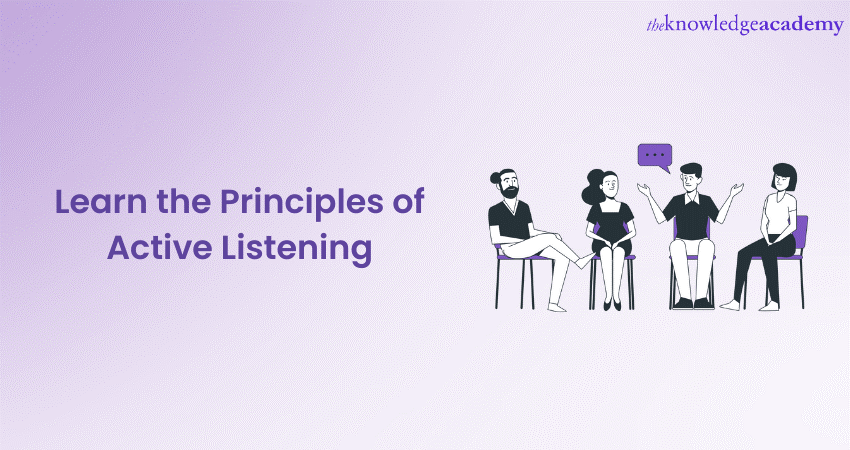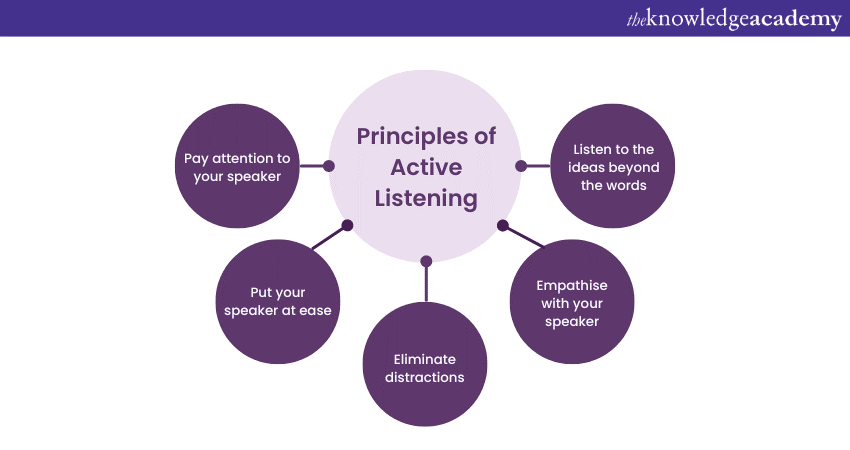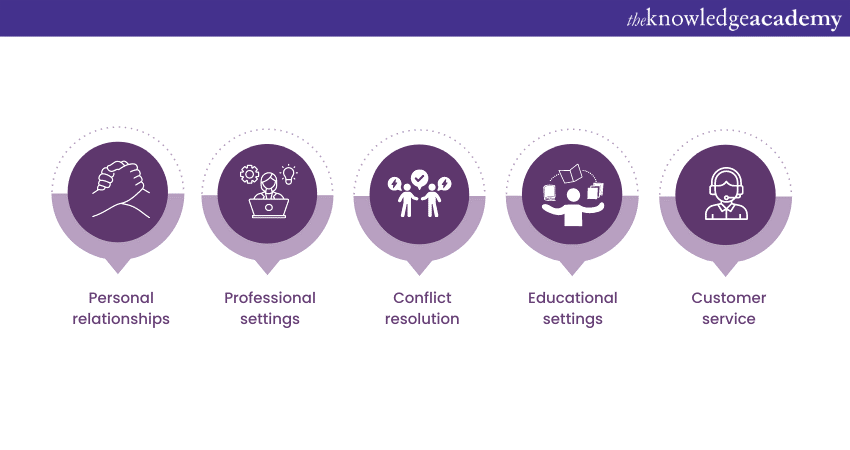We may not have the course you’re looking for. If you enquire or give us a call on 01344203999 and speak to our training experts, we may still be able to help with your training requirements.
Training Outcomes Within Your Budget!
We ensure quality, budget-alignment, and timely delivery by our expert instructors.

The Basic Principles of Active Listening are vital skills to pick up on because communication is the driving force for professional and personal relationships. Although many may consider themselves good listeners, it is little understood that Active Listening goes beyond just hearing.
Now the crux of Active Listening lies in the complete understanding of the speaker, involving undivided attention, empathy and open-mindedness. To improve your communication skills in both your personal and professional life, continue reading to gain in-depth knowledge about the Principles of Active Listening.
Table of Contents
1) A brief introduction to Active Listening
2) Exploring the various Principles of Active Listening
a) Pay attention to your speaker
b) Put your speaker at ease
c) Eliminate distractions
d) Empathise with your speaker
e) Listen to the ideas beyond the words
3) Few examples of Active Listening in various scenarios
4) Conclusion
A brief introduction to Active Listening
Active Listening is a valuable communication technique that transcends the act of simply hearing spoken words. It requires full concentration, comprehension, and response to the speaker's message. The process involves listening attentively, understanding and interpreting the speaker's words, and providing feedback, which validates to the speaker that you've fully grasped their message.
Furthermore, Active Listening is underpinned by empathy, patience, and openness, as one needs to put personal biases aside and truly understand the speaker's viewpoint, regardless of agreement. Employing non-verbal cues, such as maintaining eye contact and nodding, are significant parts of Active Listening.
Moreover, whether in personal relationships or professional settings, mastering the art of Active Listening can facilitate an improved understanding of What is Communication, and deeper connections.

Exploring the various Principles of Active Listening
The Basic Principles of Active Listening encompass paying undivided attention to the speaker, withholding judgement, reflecting on the speaker's points, clarifying any ambiguities, and summarising their thoughts accurately.
This communication approach aims to fully understand the speaker, validating their views and fostering effective dialogue. Here is a list of the various Principles described as follows:

1. Pay attention to your speaker
The first principle, paying attention to your speaker, is pivotal to Active Listening. It goes beyond merely hearing words. This means giving your full attention to the speaker and absorbing the content, context, and subtleties of their communication.
More importantly, paying attention also includes understanding non-verbal cues such as tone, pace, facial expressions, and body language, which can sometimes convey more than the words themselves. Moreover, by being fully present and attentive, you communicate respect and interest to the speaker, which encourages open and honest communication.
2. Put your speaker at ease
Putting your speaker at ease is an essential part of Active Listening. A relaxed speaker is more likely to communicate effectively, sharing their thoughts and feelings openly. This can be achieved through various techniques.
Additionally, non-verbal cues such as maintaining eye contact, nodding in agreement, and adopting an open body posture can reassure the speaker. Your verbal responses also matter. Using affirmations like "I see" and "go on" encourages the speaker and communicates your interest. Remember to keep your tone and expression neutral, irrespective of your personal views on the topic.
3. Eliminate distractions
Distractions are everywhere, hindering our ability to listen actively. Eliminating these distractions is a crucial principle of Active Listening. This could mean silencing your phone, choosing a quiet place to converse, or simply clearing your mind of other thoughts and concerns.
More importantly, it is crucial to focus solely on the speaker and the conversation at hand. By creating a distraction-free environment, you can concentrate better and engage more effectively with the speaker.
4. Empathise with your speaker
Empathy is the understanding and sharing of a fellow individual’s feelings. As an Active Listener, you must strive to step into the speaker's shoes and see things from their perspective, even if you don't agree with their point of view.
More importantly, empathetic listening involves acknowledging the speaker's emotions and offering supportive feedback. Phrases like "That must have been tough" or "I can understand why you'd feel that way" demonstrate empathy and can be particularly effective.
5. Listen to the ideas beyond the words
The final principle involves listening to ideas beyond words. This requires a degree of intuition and experience, as it involves interpreting the underlying messages or feelings that the speaker may not be expressing directly.
Additionally, it's about understanding the speaker's perspective, their motivations, and their emotions. This can be challenging, as it requires you to be in tune with the speaker and aware of subtle cues in their communication. Moreover, mastering this aspect of Active Listening can enable a person to deeply understand one another and engage in more meaningful interactions.
Learn to lead successful and meaningful conversations by signing up for the Active Listening Skills Course now!
Few examples of Active Listening in various scenarios
Active Listening Skills are essentials that are applicable in many scenarios, from personal relationships to professional environments. Its principles can enhance communication, build trust, and foster understanding.
Here are a few concrete examples of Active Listening in different scenarios, which will help illustrate how this vital skill can be employed effectively:

Personal relationships
Active Listening plays a crucial role in strengthening personal relationships, be it with friends, family, or partners. For example, when a friend shares a concern about a job, an Active Listener would attentively absorb the information and offer words of reassurance.
They would then ask follow-up questions for clarity and express empathy towards their situation. This level of engagement allows for a deeper connection and communicates care and understanding.
Professional settings
Active Listening can facilitate effective team collaboration in a professional context. Suppose a project manager is explaining the strategy for a new initiative. An Active Listener would pay full attention to the discussion and ask relevant questions to clarify any ambiguities.
They would then summarise the points in their own words to ensure full understanding. This demonstrates respect for the speaker and promotes a more productive and harmonious workplace environment.
Conflict resolution
During disagreements or conflicts, Active Listening can help defuse tension and pave the way towards a resolution. If two people are having an argument, an Active Listener would remain neutral, allowing each person to express their viewpoint without interruption.
Furthermore, they would validate their feelings, summarise their arguments, and encourage constructive dialogue. This approach can lead to mutual understanding and resolution.
Learn to be a better listener during conversations involving conflict by signing up for the Dealing with Difficult People Course now!
Educational settings
In classrooms, Active Listening can enhance the learning process. If a teacher is explaining a complex concept, an Active Listener would focus on the lecture, note down key points, and ask clarifying questions if necessary. They would also provide feedback to the teacher about their understanding, ensuring they have grasped the concept fully.
Customer service
In customer service roles, Active Listening is key to understanding and resolving customer concerns. If a customer is voicing a complaint, a customer service representative should listen attentively and especially empathise with the customer's frustration.
More importantly, they should ask questions to fully understand the issue and summarise the problem before offering a solution. This approach makes the customer feel heard and valued, improving their overall experience.
Learn to maintain an assertive yet polite and affirmative conversational tone by signing up for the Exceptional Customer Service Course now!
Conclusion
The Basic Principles of Active Listening are vital tools for effective communication across a broad spectrum of scenarios. By truly understanding and applying these principles, we can foster deeper relationships, promote understanding, and navigate conflicts more effectively. Regardless of the setting, mastering the art of Active Listening can significantly enhance our interactions with others.
Personally develop yourself in a holistic fashion by signing up for Personal Development Training Courses now!
Frequently Asked Questions
Upcoming Business Skills Resources Batches & Dates
Date
 Time Management Training
Time Management Training
Fri 24th May 2024
Fri 28th Jun 2024
Fri 26th Jul 2024
Fri 23rd Aug 2024
Fri 27th Sep 2024
Fri 25th Oct 2024
Fri 22nd Nov 2024
Fri 27th Dec 2024







 Top Rated Course
Top Rated Course


 If you wish to make any changes to your course, please
If you wish to make any changes to your course, please


